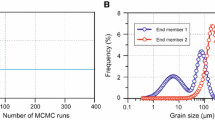Abstract
In this paper we develop a generalized statistical methodology for characterizing geochronological data, represented by a distribution of single mineral ages. The main characteristics of such data are the heterogeneity and error associated with its collection. The former property means that mixture models are often appropriate for their analysis, in order to identify discrete age components in the overall distribution. We demonstrate that current methods (e.g., Sambridge and Compston, 1994) for analyzing such problems are not always suitable due to the restriction of the class of component densities that may be fitted to the data. This is of importance, when modelling geochronological data, as it is often the case that skewed and heavy tailed distributions will fit the data well. We concentrate on developing (Bayesian) mixture models with flexibility in the class of component densities, using Markov chain Monte Carlo (MCMC) methods to fit the models. Our method allows us to use any component density to fit the data, as well as returning a probability distribution for the number of components. Furthermore, rather than dealing with the observed ages, as in previous approaches, we make the inferences of components from the “true” ages, i.e., the ages had we been able to observe them without measurement error. We demonstrate our approach on two data sets: uranium-lead (U-Pb) zircon ages from the Khorat basin of northern Thailand and the Carrickalinga Head formation of southern Australia.
Similar content being viewed by others
References
Andersen, T., 2005, Detrital zircons as tracers of sedimentary provenance: Limiting conditions from statistics and numerical simulation: Chem. Geol., v. 216, p. 249–270.
Besag, J., 1986, On the statistical analysis of dirty pictures: J. R. Stat. Soc. B, v. 48, no. 3, p. 259–279.
Brandon, M. T., 1992, Decomposition of fission-track age distributions: Am. J. Sci. v. 292, p. 535–564.
Brandon, M. T., 1996, Probability density plot for fission-track grain-age samples: Rad. Meas., v. 26, no. 5, p. 663–676.
Brooks, S. P., Friel, N., and King, R., 2003, Classical model selection via simulated annealing: J. R. Stat. Soc. B, v. 65, no. 2, p. 503–520.
Carter, A., and Bristow, C. S., 2003, Linking hinterland evolution and continental basin sedimentation by using detrital zircon thermochronology: A study of the Khorat Plateau basin, Eastern Thailand: Basin Res., v. 15, no. 2, p. 271–285.
Carter, A., and Moss, S. J., 1999, Combined detrital-zircon fission track and U-Pb dating: A new approach to understanding hinterland evolution: Geology, v. 27, no. 3, p. 235–238.
Galbraith, R. F., 1998, Graphical display of estimates having differing standard errors: Technometrics, v. 30, p. 271–281.
Galbraith, R. F., 1998, The trouble with “probability density” plots of fission track ages: Radiat. Meas., v. 29, no. 2., p. 125–131.
Galbraith, R. F., and Green, P. F., 1990, Estimating the component ages in a finite mixture: Nucl. Track Radiat. Meas., v. 1, no. 3, p. 197–206.
Green, P. J., 1995, Reversible jump Markov chain Monte Carlo computation and Bayesian model determination: Biometrika, v. 82, no. 4, p. 711–732.
Green, P. J., and Mira, A., 2001, Delayed rejection in reversible jump Metropolis–Hastings: Biometrika, v. 88, no. 4, p. 1035–1053.
Ireland, T. R., Flöttmann, T., Fanning, C. M., Gibson, G. M., and Preiss, W. V., 1998, Development of the early Paleozoic Pacific margin of Gondwana from detrital-zircon ages across the delamerian orogen: Geology, v. 26, no. 3, p. 243–246.
Ireland, T. R., and Williams, I. S. 2003, Considerations in zircon geochronology by SIMS, in Hanchar, J. M., and Hoskin, P. W. O., eds., Zircon: Reviews in mineralogy and geochemistry: Mineralogical Society of America, Washington, DC, vol. 53, p. 215–241.
Jasra, A., Holmes, C. C., and Stephens, D. A., 2005, Markov chain Monte Carlo methods and the label switching problem in Bayesian mixture modelling: Stat. Sci., v. 20, no. 1, p. 50–67.
Jennison, C., 1997, Discussion of on Bayesian analysis of mixtures with an unknown number of components: J. R. Stat. Soc. B., v. 59, no. 4, p. 778–779.
Jones, M. C., and Faddy, M. J., 2003, A skew extension of the t-distribution, with applications: J. R. Stat. Soc. B., v. 65, no. 1, p. 159–174.
Lindley, D. V., 1957, A statistical paradox: Biometrika, v. 44, no. 1, p. 187–192.
McLachlan, G. J., and Peel, D., 2000, Finite mixture models: Wiley, Chichester, UK, 419 p.
Richardson, S., and Green, P. J., 1997, On Bayesian analysis of mixture models with an unknown number of components: J. R. Stat. Soc. B, v. 59, no. 4, p. 731–792.
Richardson, S., Leblond, L., Jaussent, I., and Green, P. J., 2002, Mixture models in measurement error problems, with reference to epidemiological studies: J. R. Stat. Soc. A, v. 165, no. 3, p. 549–566.
Robert, C. P., 2001, The Bayesian choice: From decision-theoretic foundations to computational implementation, 2nd ed.: Springer, New York, 604 p.
Robert, C. P., and Casella, G., 2004, Monte Carlo statistical methods, 2nd ed.: Springer, New York, 645 p.
Sambridge, M. S., and Compston, W., 1994, Mixture modelling of multi-component data sets with application to ion-probe zircon ages: Earth Planet. Sci. Lett., v. 128, no. 3, p. 373–390.
Sircombe, K. N., 2004, AGEDISPLAY: An EXCEL workbook to evaluate and display univariate geochronological data using binned frequency histograms and probability density distributions: Comp. Geosci., v. 30, p. 21–31.
Stephens, M., 2000, Dealing with label switching in mixture models: J. R. Stat. Soc. B, v. 62, no. 4, p. 795–809.
Stern, R. A., and Amelin, Y., 2003, Assessment of errors in SIMS zircon U-Pb geochronology using a natural zircon standard and NIST SRM 610 glass: Chem. Geol., v. 197, no. 1, p. 111–142.
Vermeesch, P., 2004. How many grains are needed for a provenance study?: Earth. Planet. Sci. Lett., v. 224. p. 441–451.
Author information
Authors and Affiliations
Corresponding author
Rights and permissions
About this article
Cite this article
Jasra, A., Stephens, D.A., Gallagher, K. et al. Bayesian Mixture Modelling in Geochronology via Markov Chain Monte Carlo. Math Geol 38, 269–300 (2006). https://doi.org/10.1007/s11004-005-9019-3
Received:
Accepted:
Published:
Issue Date:
DOI: https://doi.org/10.1007/s11004-005-9019-3




